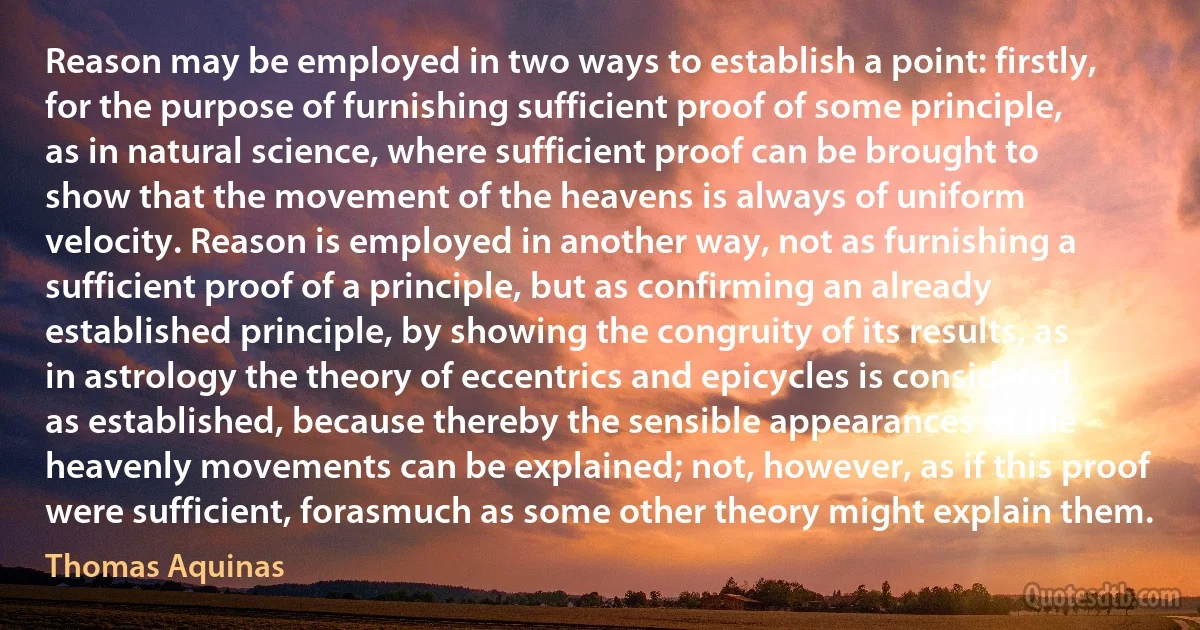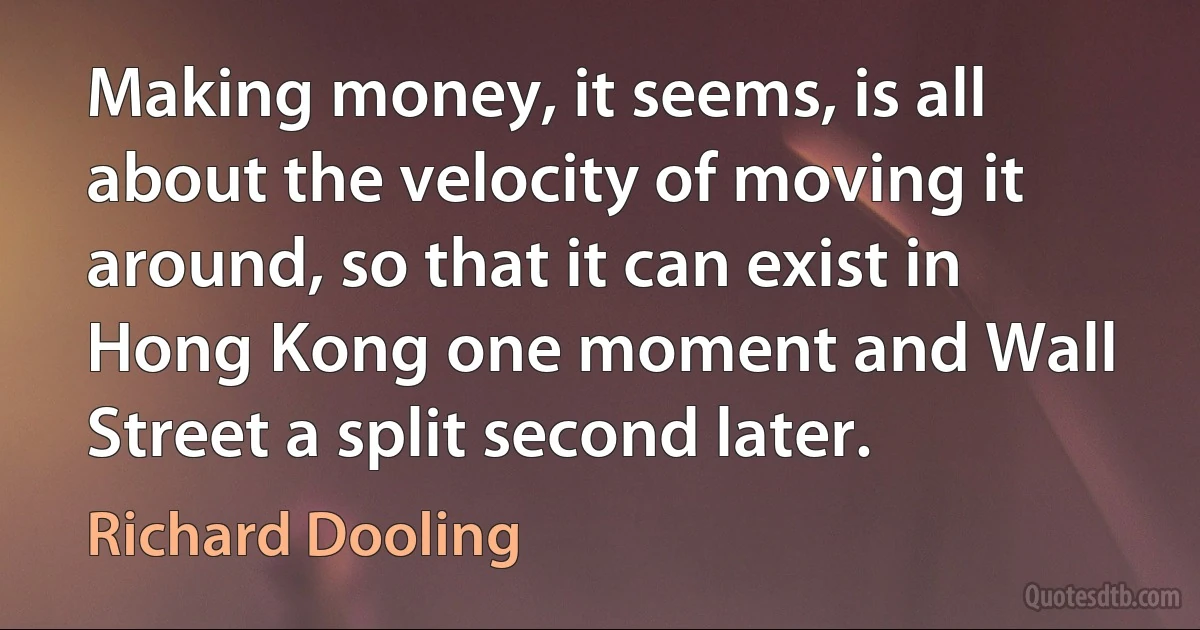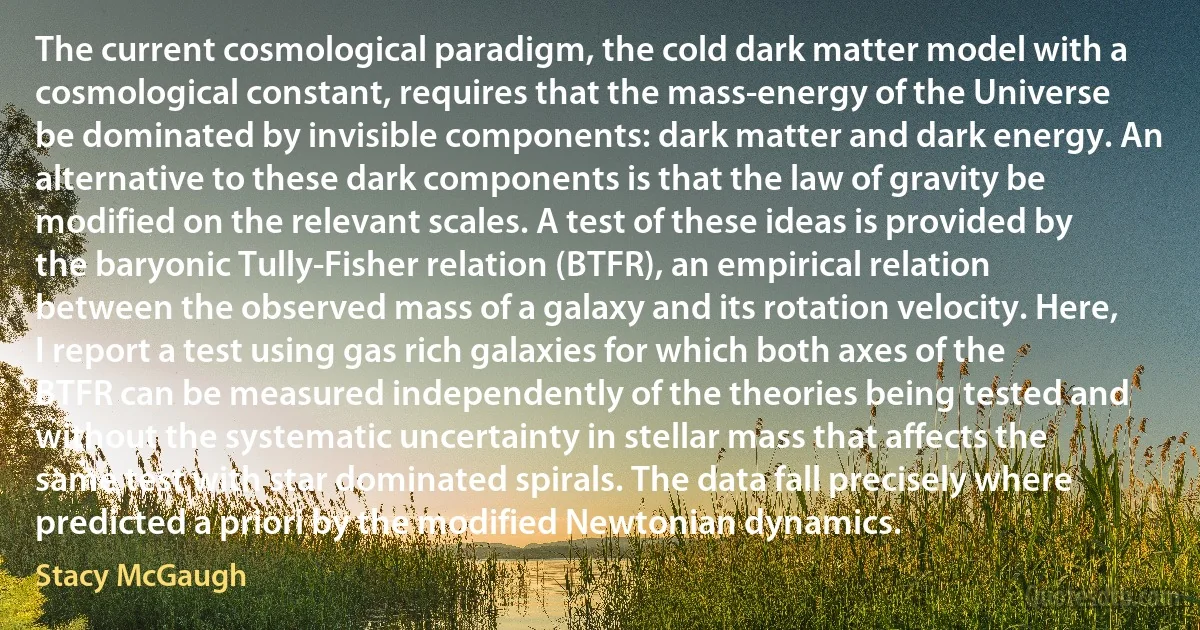Velocity Quotes - page 3
One can find meaning in poetry as well as in science in the contemplations of a flower as well as in the grasp of an equation. We can be filled with wonder as we stand under the majestic dome of the night sky and see the myriad lights that twinkle and shine in its seemingly infinite depths. We can also be filled wit awe as we behold the meaning of the formulae that define the propagation of light in space, the formation of galaxies, the synthesis of chemical elements, and the relation of energy, mass and velocity in the physical universe. The mystical perception of oneness and the religious intuition of a Divine intelligence are as much a construction of meaning as the postulation of the universal law of gravitation.

Ervin László
A question which has long troubled astronomers and physicists is what becomes of the energy that is continually being poured out into space by the sun and the stars. To this question a complete answer is given by the new theory. It is used up, diluted, or degraded, by the expansion of the universe. ...the light travelling through the expanding universe and, so to say, trying to reach a particular star, or stellar system, which is continually receding with great velocity, is losing energy in trying to catch up with it. It is this degradation of the light, technically known as the redshift of the spectral lines, by which we become aware of the receding velocities of the extra-galactic nebulae. It can be shown that the decrease of the total amount of radiant energy in the universe by this degradation exceeds the increase by the radiation of the stars. It would not be correct, however, to conclude that the expansion is caused by the energy thus lost by the radiation...

Willem de Sitter
Gravitation is entirely independent of everything that influences other natural phenomena. It is not subject to absorption or refraction, no velocity of propagation has been observed. You can do whatever you please with a body, you can electrify or magnetise it, you can heat it, melt or evaporate it, decompose it chemically, its behaviour with respect to gravitation is not affected. Gravitation acts on all bodies in the same way, everywhere and always we find it in the same rigorous and simple form, which frustrates all our attempts to penetrate into its internal mechanism.

Willem de Sitter
Brook Taylor... in his Methodus Incrementorum Directa et Inversa (1715), sought to clarify the ideas of the calculus but limited himself to algebraic functions and algebraic differential equations. ...Taylor's exposition, based on what we would call finite differences, failed to obtain many backers because it was arithmetical in nature when the British were trying to tie the calculus to geometry or to the physical notion of velocity.

Morris Kline
I wonder if any of them can tell from just looking at me that all I am is the sum total of my pain, a raw woundedness so extreme that it might be terminal. It might be terminal velocity, the speed of the sound of a girl falling down to a place from where she can't be retrieved. What if I am stuck down here for good.

Elizabeth Wurtzel
Working with lots of old media clients, I've had a front-row seat on the ascension of new social players and the decline of traditional news outlets. And it's clear to me that old media has an awful lot to learn from social media, in particular in five key areas: relevance, distribution, velocity, monetization, and user experience.

Ryan Holmes
E = mc2 really applies only to isolated bodies at rest. In general, when you have moving bodies, or interacting bodies, energy and mass aren't proportional. E = mc2 simply doesn't apply. ...For moving bodies, the correct mass-energy equation is
E=\frac {mc^2} {\sqrt{1-\frac{v^2} {c^2}}}
where v is the velocity. For a body at rest (v=0), this becomes E = mc2. ...we must consider the special case of particles with zero mass... examples include photons, color gluons, and gravitons. If we attempt to put m = 0 and v = c in our general mass-energy equation, both the numerator and denominator on the right-hand-side vanish, and we get the nonsensical relation E = 0/0. The correct result is that the energy of a photon can take any value. ...The energy E of a photon is proportional to the frequency f of the light it represents. ...they are related by the Planck-Einstein-Schrödinger equation E = hf, where h is Plank's constant.

Frank Wilczek
As we all know, the singularity in the art of Bach is the fusion of both levels and lines, the horizontal and vertical line. It's a real wonder to see that the creation and forming of the horizontal line, the polyphonic structure, also results in this perfect, beautiful vertical line, the harmonic line. As we also know, Bach already used the full harmonic range and radius as no composer before him. My artistic aim of course is to point out the horizontal line in soloistic manner in a dynamically elastic way, but in the same breath to form the harmonic line in a bright field of color (I would call it "harmonic articulation”), to achieve a particular atmosphere of emotions and moods, drama, velocity, vividness, and so on. As we can imagine, these are high demands ...

Burkard Schliessmann
The following passage is one of those cited by Copernicus himself in his preface to De Revolutionibus 'The Syracusan Hicetas, as Theophrastus asserts, holds the view that the heaven, sun, moon, stars, and in short all of the things on high are stationary, and that nothing in the world is in motion except the earth, which by revolving and twisting round its axis with extreme velocity produces all the same results as would be produced if the earth were stationary and the heaven in motion....'

Cicero
Motion with respect to the universal ocean of aether eludes us. We say, "Let V be the velocity of a body through the aether", and form the various electromagnetic equations in which V is scattered liberally. Then we insert the observed values, and try to eliminate everything which is unknown except V. The solution goes on famously; but just as we have got rid of all the other unknowns, behold! V disappears as well, and we are left with the indisputable but irritating conclusion -
::: 0 = 0
This is a favourite device that mathematical equations resort to, when we propound stupid questions.

Arthur Eddington
Momentum may be roughly described as quantity motion. A body moving at a speed of say twenty an hour, has a certain quantity of motion. If the body goes forty miles an hour there is twice as motion; or if twice as much matter goes twenty miles hour, there is also twice as much motion. Momentum is measured by the quantity of matter moving at a rate mass \times velocity.

William Kingdon Clifford
We--by whom I mean anyone over sixty--commit two offenses just bu existing. One is Lack of Velocity. We drive too slowly, walk to slowly, talk too slowly. The world will do business with dictators, perverts, and drugs barons of all stripes, but being slowed down it cannot abide. Our second offence is being Everyman's memento mori. The world can only get comfy in shiny-eyed denial if we are out of sight.

David Mitchell (author)
We--by whom I mean anyone over sixty--commit two offenses just bu existing. One is Lack of Velocity. We drive too slowly, walk to slowly, talk too slowly. The world will do business with dictators, perverts, and drugs barons of all stripes, but being slowed down it cannot abide.

David Mitchell (author)



